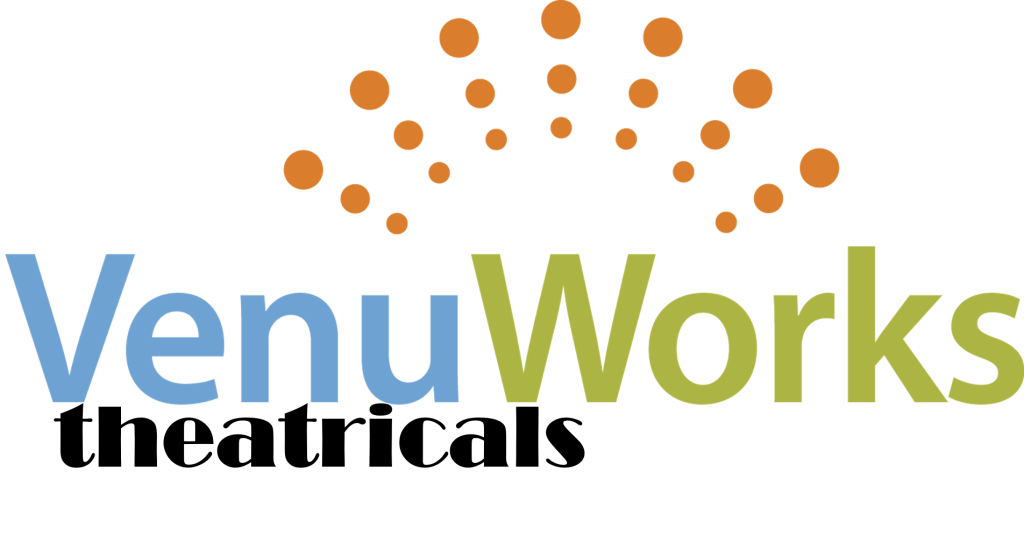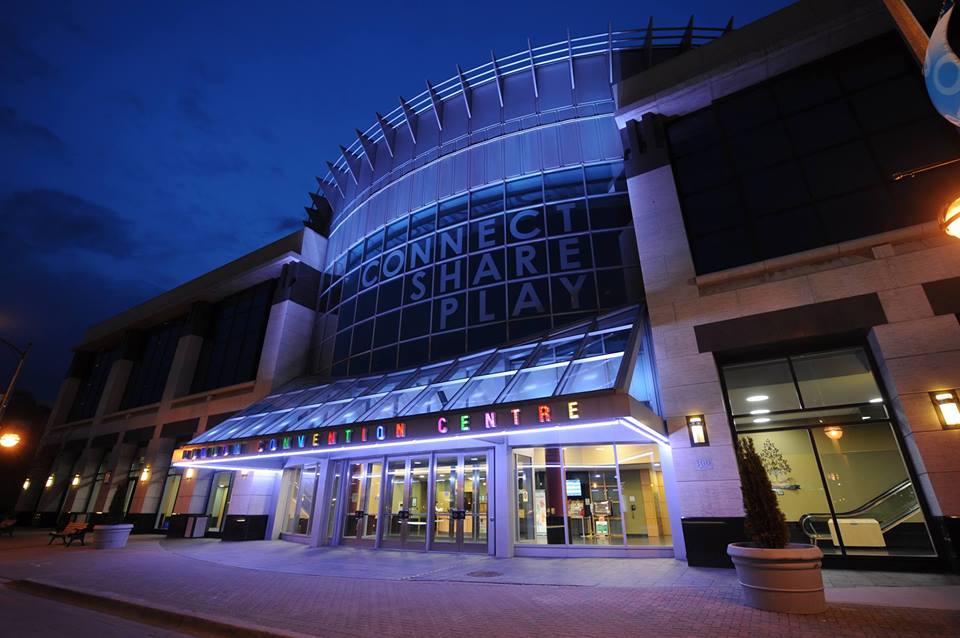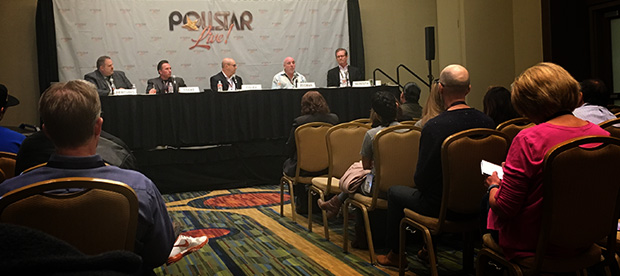Announcing VenuWorks Theatricals

VenuWorks plans to produce theatrical events under the banner VenuWorks Theatricals, led by IAVM member Steve Peters, VenuWorks founder and president, and Michael Londra, an international singer and producer.
“In 2014, VenuWorks joined the ranks of Broadway producers. This afforded me involvement in an area that I am quite passionate about – producing shows,” said Steve Peters, VenuWorks founder and president, in a statement. “VenuWorks Theatricals is something that I have dreamed about creating for years. With Michael’s partnership and the business plan we have established, I could not be more excited about the future of VenuWorks Theatricals.”
VenuWorks Theatricals’ first project is a Christmas musical titled NOËL, written by Artemis Fowl author Eoin Colfer with music by Liam Bates. It will debut at the National Opera House in Ireland on December 19, 2016, with plans for a U.S. premier in 2017.
VenuWorks Theatricals will also produce a Michael Londra national tour in 2017.
“I have always enjoyed producing as much as performing in events. Working with Steve while producing and performing was an opportunity that I could not pass up,” said Londra in a statement. “I am excited to produce new shows for Broadway, to bring artists and theatrical events to the Midwest, and to collaborate with the entire VenuWorks team.”
Naming Rights to London Convention Centre to be Sold

Spectra by Comcast Spectacor is selling the naming rights and commercial sponsorships for the London Convention Centre (LCC) in Ontario, Canada.
“Spectra has an outstanding reputation in London for their many successes at the Budweiser Gardens,” said Lori Da Silva, general manager and CEO of the London Convention Centre Corp., in a statement. “With their incredible resources, their knowledge of London and the Province, and their ability to identify the best sponsors for the right situations, this is a win-win situation for the LCC and Spectra. The naming rights partner will be integral in the economic growth and subsequent improvement in the physical property.
“We are always exploring new strategies that will help us generate revenue for the London Convention Centre,” Da Silva continued. “Spectra’s Corporate Partnership Services is a leader in valuing, soliciting, and negotiating naming rights for an assortment of clients worldwide. Their experience and expertise in this field will assist us in developing potential additional revenue for the convention centre.”
The LCC plays host of up to 400 annual events, contributing up to CAN$20 million to the local economy each year. The center is an internationally certified AIPC Gold Standard venue offering more than 63,000 square feet of meeting and exhibit space.
“The naming rights to the London Convention Centre presents a significant opportunity for a business partner to integrate their brand into a venue that has become so important to the people of southwestern Ontario,” said Spectra’s Liam Weseloh, regional vice president for the company who will lead the team’s efforts in securing the naming rights in London, in a statement. “Not only will the naming rights partner receive millions of unique impressions from the local community, but will also have the ability to showcase their products and services in front of hundreds of organizations from around the world who will visit and use the centre.”
(Image: Facebook)
This Year’s Joseph A. Floreano Scholarship + Internship PAMC Recipients

The IAVM Foundation is proud to announce the Joseph A. Floreano Scholarship + Internship Program recipients for the 2016 Performing Arts Managers Conference (PAMC). The awards recognize deserving individuals who demonstrate leadership, character, community involvement, and the potential to be future leaders in the venue management industry.
Safety and Security On Stage

Between IAVM’s Academy for Venue Safety and Security (AVSS), GuestX, and SevereWeather Preparedness (currently underway), and the safety and security session at Pollstar, venue managers and security professionals have recently shared a tremendous amount of insight and resources with one another.
The Pollstar panel, moderated by Eric Colby (AVSS faculty), featuring Lee Zeidman (STAPLES Center, Microsoft Theater, L.A. Live); Jim Mercurio (Levi’s Stadium); Captain Phil Cooke (Super Bowl 50, Santa Clara Police Department); and Cory Meredith (Staff Pro), explored lessons learned and smart practices shaped by recent incidents affecting the safety and security landscape.
Fresh off of Super Bowl 50, Mercurio and Cooke described an operation of massive proportions, including 15,000-plus credentialed staff and crew, 200 magnetometers, and more than 1,000 calls for service (janitorial, medical, etc.) during the game. To supplement the onsite operations, a situation room monitored everything from area traffic to social media content and global events (social media tracking led to preventing a few attempts by guests to access the field).
The relationship between visible and invisible security was a significant point of discussion during the session, and monitoring social media content associated with an event is one example that was shared of the emerging ways that venue teams are supplementing traditional frontline security. Having visible police with a sidearm remains an important deterrent, but as the panel discussed, an invisible layer of security and support behind them is an important aspect of modern security.
Three Ways to Improve Your Venue Safety and Security
During the session, Zeidman shared three very accessible ways that every venue manager can improve their safety and security.
1. Foster Great Relationships With Law Enforcement
“We host training sessions in our venues, have weekly meetings to cover upcoming events, and share extra tickets to games and events with the police and fire departments whenever we can,” Zeidman said.
2. Table Top Exercises
At Zeidman’s venues, issues such as earthquakes, bomb threats, and active attacker scenarios are worked into staff exercises that engage all staff positions—with Zeidman emphasizing all staff.
Similarly, at AVSS and GuestX this week, all attendees participated in IAVM’s American Airlines Center Experience. Developed by Paul Turner, CFE, CSSP (AT&T Stadium) and Ed Klima (Dover International Speedway), the event included a table top exercise for more than 200 attendees—immersing several small groups into focused discussions on managing various aspects of a large rigging accident occurring during a concert.
“The exercise enabled the entire group to collaborate on multiple aspects of a very plausible scenario,” Turner said, “And it equipped everyone with a great example of how to coordinate training exercises with their own teams back home.”
3. Improving Visibility
Following the Paris attacks, Zeidman shared that he expanded the use of K9 Units to include public areas around the venue instead of primarily focusing on vehicle searches in private areas. Improving visibility, and doing so consistently, is very important to Zeidman, regardless of the type of event or the makeup of the crowd attending.
“People want to see a show of force because they want to feel comfortable and safe,” Zeidman said. “And it shouldn’t change because the event changes. I’m not going to be the one who allowed something to happen at a certain event because we downplayed a security plan.”
As both the session at Pollstar, and the sellout crowd at AVSS show, venue safety and security is demanding more attention and training than ever, and will undoubtedly continue to draw us together for new thinking and ongoing collaboration to ensure a vibrant, safe, and secure future.
Here’s a Musical Tablecloth
For event attendees no longer amused by dinner conversation, there’s a new development that may attract their attention: the musical tablecloth.
“The tablecloth is woven with conductive fibers and embedded with sensors. The on/off switch? Human touch,” Rob Gruber reported for Reuters Video.
Please watch the video above to learn more. Do you think this is something that attendees would like at events in your venues? Please share your thoughts in the comments section below.
Do you want to receive a Front Row News weekly digest?
Categories
- Allied (861)
- Architecture (147)
- Arenas (747)
- Career (897)
- Convention Centers (895)
- Education (623)
- Events (1,544)
- Food & Beverage (193)
- Foundation (113)
- Guest Experience (1,496)
- Industry News (2,270)
- Leadership (1,888)
- Marketing (150)
- Membership (2,000)
- Music (213)
- Performing Arts Centers (454)
- Professional Development (409)
- Research (127)
- Safety & Security (442)
- Sports (763)
- Stadiums (608)
- Student (159)
- Technology (516)
- Ticketing (92)
- Touring (82)
- Trends (364)
- Uncategorized (743)
- Universities (218)
- Video (25)
- Young Professional (198)
Twitter Feed
- Twitter feed loading
Recent Posts
- Venuworks and ATG Entertainment Selected to Manage Fresno Convention and Entertainment Center
- Seattle Convention Center Announces Strategic Leadership Appointment and Growth Initiatives for 2026
- Peggy Daidakis Humbly Made Convention Center History
- Welcome to Our Newest Members
- New Member Benefit! IAVM Partners with Advantage Training to Elevate Staff Readiness and Guest Experience
Categories
- Allied
- Architecture
- Arenas
- Career
- Convention Centers
- Education
- Events
- Food & Beverage
- Foundation
- Guest Experience
- Industry News
- Leadership
- Marketing
- Membership
- Music
- Performing Arts Centers
- Professional Development
- Research
- Safety & Security
- Sports
- Stadiums
- Student
- Technology
- Ticketing
- Touring
- Trends
- Uncategorized
- Universities
- Video
- Young Professional
Archives
- December 2025
- November 2025
- October 2025
- September 2025
- August 2025
- July 2025
- June 2025
- May 2025
- April 2025
- March 2025
- February 2025
- January 2025
- December 2024
- November 2024
- October 2024
- September 2024
- August 2024
- July 2024
- June 2024
- May 2024
- April 2024
- March 2024
- February 2024
- January 2024
- December 2023
- November 2023
- October 2023
- September 2023
- August 2023
- July 2023
- June 2023
- May 2023
- April 2023
- March 2023
- February 2023
- January 2023
- December 2022
- November 2022
- October 2022
- September 2022
- August 2022
- July 2022
- June 2022
- May 2022
- April 2022
- March 2022
- February 2022
- January 2022
- December 2021
- November 2021
- October 2021
- September 2021
- August 2021
- July 2021
- June 2021
- May 2021
- April 2021
- March 2021
- February 2021
- January 2021
- December 2020
- November 2020
- October 2020
- September 2020
- August 2020
- July 2020
- June 2020
- May 2020
- April 2020
- March 2020
- February 2020
- January 2020
- December 2019
- November 2019
- October 2019
- September 2019
- August 2019
- July 2019
- June 2019
- May 2019
- April 2019
- March 2019
- February 2019
- January 2019
- December 2018
- November 2018
- October 2018
- September 2018
- August 2018
- July 2018
- June 2018
- May 2018
- April 2018
- March 2018
- February 2018
- January 2018
- December 2017
- November 2017
- October 2017
- September 2017
- August 2017
- July 2017
- June 2017
- May 2017
- April 2017
- March 2017
- February 2017
- January 2017
- December 2016
- November 2016
- October 2016
- September 2016
- August 2016
- July 2016
- June 2016
- May 2016
- April 2016
- March 2016
- February 2016
- January 2016
- December 2015
- November 2015
- October 2015
- September 2015
- August 2015
- July 2015
- June 2015
- May 2015
- April 2015
- March 2015
- February 2015
- January 2015
- December 2014
- November 2014
- October 2014
- September 2014
- August 2014
- July 2014
- June 2014
- May 2014
- April 2014
- March 2014
- February 2014
- January 2014
- December 2013
- November 2013
- October 2013
- September 2013
- August 2013
- July 2013
- June 2013
- May 2013
- April 2013
- March 2013
- February 2013
- January 2013
- May 2012
- March 2012
- December 2011
- November 2011
- October 2011
Recent Comments
- Frank Bradshaw, Ph.D., CVE on John Meyer, CVE, a Tireless Advocate of Certification for Venue Professionals, Has Died
- Neil Sulkes on Hilary Hartung, Friend to Many in Venue Marketing, Has Left Us
- Jason Parker, CVE on The Devastation of Hurricane Helene and How We Can Support One Another
- Larry Perkins on Touhey Testifies Against Speculative Ticketing Before Congressional Subcommittee
- Peter Secord on Major Players for Planned Elkhart Amphitheater Were in the Mix at VenueConnect
